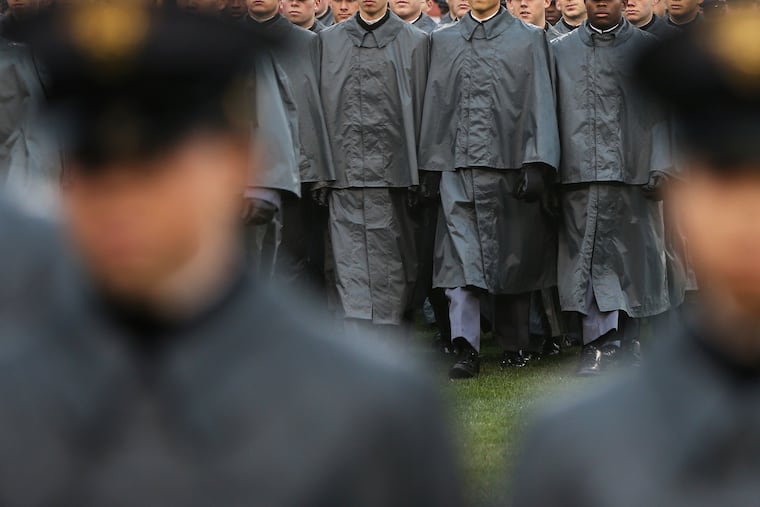What’s the story behind ‘white power’ signs allegedly flashed before Army-Navy game?
Navy midshipmen and Army cadets allegedly flashed the "OK" hand-sign that anti-hate groups say is linked to white nationalists. The academies are investigating.

While both the Army and Navy military academies are investigating whether their respective cadets and midshipmen flashed “white power” hand signs during an ESPN pregame broadcast at the Army-Navy Game on Saturday, this wasn’t the first time the signs have been seen at prominent events.
Here’s more about the recent history of this sign.
When have we seen this used before?
In February 2017, shortly after President Donald Trump was inaugurated, Stephen Miller, one of his key advisers on policies that banned Muslims from entering the United States and separated Latino migrant children from their parents, was photographed appearing to flash the hand signs in the White House briefing room. (The sign, which is based on the gesture for saying “OK,” shows three fingers out to make the "W" for white and a thumb and forefinger pointed down to make the "P" for power, groups that monitor hate symbols say.)
» READ MORE: West Point investigates cadets’ hand symbol with possible links to white power at Army-Navy ‘College GameDay’ show
» READ MORE: Naval Academy is also investigating a possible ‘white power’ gesture at Army-Navy game in Philadelphia
There was also speculation that Zina Bash, a former Trump administration special assistant and former law clerk for U.S. Supreme Court Justice Brett Kavanaugh when he sat on the U.S. Court of Appeals, had made the “white power” sign as she sat behind Kavanaugh during his Senate conformation hearings.
Her husband, John Bash, condemned the accusations, calling them “repulsive.”
When did this sign become associated with white nationalists?
The Anti-Defamation League in September 2019 included the sign on its hate symbols list, Robyn Burstein, senior associate regional director, said Monday. The organization noted that use of the symbol in most contexts is harmless.
"In 2017, the ‘OK’ hand gesture acquired a new and different significance thanks to a hoax by members of the website 4chan to falsely promote the gesture as a hate symbol, claiming that the gesture represented the letters ‘wp,’ for ‘white power,’” the Anti-Defamation League said.
By 2019, however, some white supremacists had begun to use the sign, such as when Brenton Tarrant flashed the symbol during a March 2019 courtroom appearance soon after his arrest in the murder of 50 people at mosques in Christchurch, New Zealand.
The Southern Poverty Law Center said that while the OK hand sign was adopted “first by white nationalists and then by 4chan trolls intent on ‘triggering the libs,’ the well-known hand signal’s use points to deeper concerns.”
“The problem, of course, is that there are white nationalists, neo-Nazis, and Klansmen who have increasingly begun using the symbol both to signal their presence to the like-minded, as well as to identify potentially sympathetic recruits among young trolling artists flashing it,” the law center said.
How can you tell if this symbol is being used to promote white nationalism?
The Anti-Defamation League has described the sign as a hate symbol depending on the context on how it is used. It has urged that “particular caution must be made when evaluating this symbol” because many people have been falsely accused of being racist or adhering to white supremacy when using the OK gesture in its traditional sense.
“The smirk that almost inevitably accompanies the ‘OK’ sign, that simplest of hand signals, is the dead giveaway in the shroud of internet-age befuddlement: Does the sign, the thumb and forefinger joined together in a circle, the remaining three fingers splayed out behind, mean ‘all’s good'? Or does it mean ‘white power’ instead?” the Law Center wrote in September 2018.
One needs to know the motivation, Burstein said, “before jumping to any conclusions.”